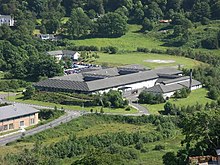플로이드 E.로메스베르크
Floyd E.플로이드 E.로메스베르크 | |
|---|---|
| 로 알려져 있다. | DNA 인간 게놈 메타게노믹스 합성유전체학 |
| 과학 경력 | |
| 필드 | 생화학자, 유전학자 |
| 기관 | 스크립스 리서치 |
| 웹사이트 | 로메스버그 랩 |
플로이드 E. Romesberg는 이전에 캘리포니아 샌디에이고에 있는 Scripps Research에서 미국의 생명공학학자, 생화학자, 유전학자였다.[1]그는 첫 번째 부자연스러운 베이스 페어(UBP)를 만든 팀을 이끌면서 2012년 [2]4글자의 유전 알파벳을 6글자로, 2014년 첫 번째 반합성 [3][4]유기체, 2017년 연속 자손에게 유전 물질을 재생산할 수 있는 최초의 기능성 반합성 유기체 등으로 확장한 것으로 알려져 있다.[5]그는 타이틀 IX 조사를 받고 스크립스를 떠났다.
수상 및 지명
참조
- ^ "Star scientist leaves Scripps Research under mysterious circumstances". San Diego Union-Tribune. 2019-08-09. Retrieved 2021-08-31.
{{cite web}}: CS1 maint : url-status (링크) - ^ Malyshev, Denis A.; Dhami, Kirandeep; Quach, Henry T.; Lavergne, Thomas; Ordoukhanian, Phillip (24 July 2012). "Efficient and sequence-independent replication of DNA containing a third base pair establishes a functional six-letter genetic alphabet". Proceedings of the National Academy of Sciences of the United States of America. 109 (30): 12005–12010. Bibcode:2012PNAS..10912005M. doi:10.1073/pnas.1205176109. PMC 3409741. PMID 22773812.
- ^ Malyshev; et al. (7 May 2014). "A Semi-Synthetic Organism with an Expanded Genetic Alphabet". Nature. 509 (7500): 385–8. Bibcode:2014Natur.509..385M. doi:10.1038/nature13314. PMC 4058825. PMID 24805238.
- ^ Andrew Pollack (May 7, 2014). "Scientists Add Letters to DNA's Alphabet, Raising Hope and Fear". New York Times. Retrieved 17 December 2018.
- ^ Chris Jennewein (29 November 2017). "Scripps Research Creates First 'Semi-Synthetic' E. Coli Bacteria". Times of San Diego. Retrieved 17 December 2018.
- ^ "Nobel Laureate Signature Award for Graduate Education in Chemistry". American Chemical Society.
- ^ "Scripps Research chemist receives prestigious Royal Society of Chemistry Award". 8 May 2018. Retrieved 17 December 2018.
외부 링크


